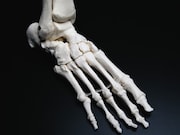Ultrasound readings of left or right foot can predict good versus poor bone quality
TUESDAY, Feb. 26, 2019 (HealthDay News) — Ultrasonography (US) of the calcaneus is efficient for screening bone health, according to a study published in the March issue of the Journal of the American Osteopathic Association.
Carolyn Komar, Ph.D., from the West Virginia School of Osteopathic Medicine in Lewisburg, and colleagues recruited 99 patients to establish data ranges for calcaneus US that correspond to bone mineral density (BMD) stratification identified by dual-energy X-ray absorptiometry (DXA). The left calcaneus and right calcaneus of the patients were scanned with US, and blood was collected from a finger prick for vitamin D analysis.
The researchers found that US readings of either the left or right foot could predict good versus poor bone quality, with no differences between the scans of the left foot versus the right foot. For the left and right feet, the area under the curve values for US BMD T scores were 0.69 and 0.68, respectively. No correlation was seen between DXA- and US-assessed BMD and vitamin D concentrations. There were negative correlations between the DXA BMD T scores and vitamin D concentration of the spine and right hip.
“Using ultrasound to scan the heel won’t give us all the information we could gather with a full DXA scan,” Komar said in a statement. “However, it gives us a clear enough snapshot to know whether we should be concerned for the patient.”
Copyright © 2019 HealthDay. All rights reserved.








